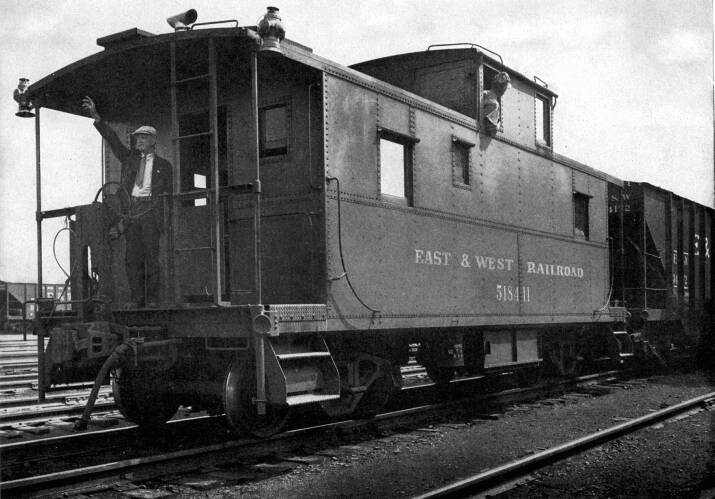 The Red Caboose
The Red Caboose
Just as every store, factory or other place of business must
have an office, so must the freight train have an office to transact
its business. The freight train really does a big business. It
handles large quantities of merchandise every day. It is true,
the train does not buy and sell merchandise like a store, but
it produces and sells transportation—transportation of merchandise
of every sort—and it must keep a complete record of all transportation
produced and sold.
The conductor in charge of each freight train must keep a careful
record of each carload or less-than-carload shipment handled by
his train. The record must show the contents of each car and package
and barrel and crate, by whom each was shipped, the station at
which it was received, the station at which it is to be unloaded
or left, and the person, firm or company to which it is consigned.
The record must also show the weight of each shipment, whether
the shipper or the consignee is to pay the freight charges, and
other necessary information. If there are empty cars in the train,
the conductor must keep a careful record of them also.
In order to have a suitable place to work and keep his records,
the conductor is provided with an office car. This office car
is attached to the rear end of the train and is known by the odd
name of "caboose." Just how it was christened "caboose"
no one seems to know. Many years ago the conductor's car was called
the "cabin," and it is possible that "caboose"
was derived from that name.
The caboose is more than an office, however. It serves also
as the "home" of the train crew while they are on the
road. The trainmen or brakemen make their headquarters in the
caboose when they are not attending to their duties outside. The
caboose is also occupied occasionally by caretakers of livestock,
perishable fruits and vegetables, and others whose duties require
them to ride freight trains.
Lockers are provided for members of the crew and for the necessary
flags, lanterns, light repair tools, oils and other supplies.
A coal stove provides heat in winter and for warming the crew's
food at meal time. The caboose is equipped with a table, a drinking-water
cooler, benches and chairs, a washstand and other conveniences,
and it is lighted by oil lamps.
The odd-looking cupola atop the car is the "watch tower"
of the train. When the train is running, the conductor or one
of the brakemen usually sits in the tower and watches in both
directions to see that the train is running satisfactorily and
that nothing is approaching from the rear.
Doors open onto platforms at each end of the car. On one platform
can be seen a wheel which operates the brakes when the car is
not attached to a train. A ladder goes to the roof for the crew
to climb up to give signals to the locomotive engineer or to another
member of the train crew. Brackets on the corners of the car hold
signal lights when the caboose is attached to a train. Some cabooses
are built of wood; some, like the one in the picture, are built
of steel.
The rubber hose on the rear of the car is a part of the air-hose
system that controls the air-brakes. The object with the two "eyes"
just beyond the air hose is an automatic coupler. Cars are held
together by couplers, which grip together like two cupped hands
and hold firmly until released by a trainman.
The freight train conductor supervises the crew and has charge
of all the cars in the train. He has a "ticket," or
a waybill, for each car or shipment in his train. The waybills
tell him the contents of each car in his train, and to what station,
yard or junction point each car or shipment in the train is to
be delivered.
The conductor has to see that his train is thoroughly inspected
before it leaves the terminal and that each member of his crew
understands the orders governing the movement of the train. He
makes out daily reports concerning the crew, the cars he picks
up or drops off between terminals, the railroad they belong to,
and so on.
The freight conductor gets his training from years of experience
as a freight brakeman. In addition to having the required education,
he must pass oral and written examinations to qualify for his
job. He must be physically sound, and, like other men who are
responsible for train operations, he must be a man of good character
and temperate habits.
I've Been Working
on the Railroad | Contents Page
|







